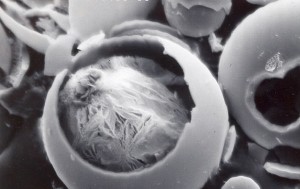Porous glass may help deliver medicine
The small intestines are responsible for a great deal of nutritional absorption, but to get there, one must pass through the stomach, with all of its hideously destructive acids. One clever way to ensure that drugs make it into the small intestines intact is the time-honored “timed-release” delivery. Drugs are specially coated to survive the trip through the stomach. The coating breaks down eventually, but hopefully not before the cargo reaches its target.
But again – there is some variability in the way the stomach works. Digestion really isn’t time-dependent. The stomach can empty its contents into the small intestines much sooner or much later than expected. In either case, the drug doesn’t get delivered in the right amount. Either the time-release coating isn’t broken down or it broke down before reaching the small intestines.
Porous glass microspheres can help control the time-release of a drug. They can be created using several different materials, including bioactive glasses, ceramics, biopolymers and silicates. These structures have small cavities that can hold a precious pharmaceutical payload. When encapsulated in a glass microsphere, drugs can better survive the stomach, and offer a better time-release mechanism. This leads to a more reliable way to deliver drugs at the right time and in the right place. It can also protect drugs from naturally occurring substances in the GI tract that might bind with a drug and make it unavailable to the body.
One of the desirable characteristics of the glass microspheres is that they float! They can pass easily through the digestive tract and offer better timed-release performance. Glass microspheres won’t help with drugs that are likely to break down in acid, but they can assist in delivering timed-release drug therapies.
Photo Credit: Savannah River Site, via Flickr.com





